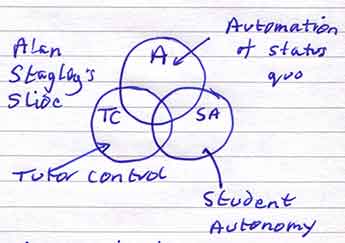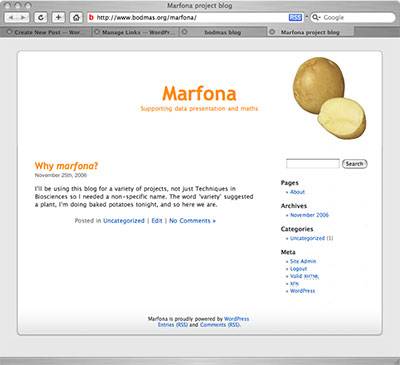Note added 8th Dec: Alan Staley’s PowerPoint is now available online, along with the other presentations from an interesting day

Alan Staley presented a slide with the Venn diagram above to explain his way of classifying Moodle courses. The slide had many examples, notes, categories on it – I have pulled out the central image.
The Automation of status quo circle represents using Moodle as a ‘filing cabinet’ to make handouts, schemes of work and PowerPoints (and screencasts as I am using more) available to students. It is a useful support function but the actual learning bit may not be happening within Moodle. In Moodle this corresponds to courses that make exclusive use of the ‘resources’ features.
The Tutor Control circle represents the use of some Moodle ‘activities’ such as quizzes, forum discussions with tutor question and student response format, Assignment functions and some use of tracking and the grade book. The tutor is laying out the path and the students can work through the activities and receive feedback and reassurance that they are learning.
The Student Autonomy circle represents Moodle courses in which there are case studies, peer activities, collaborative work, perhaps using forums with student initiated topics, perhaps a wiki where students can store and refine ideas and post information for modification by other students. One of Alan’s colleagues is using the Workshop module – students are assessing other students’ work by means of the criteria. In this way, each student will come to understand the assessment critieria through negotiating the grades with other students – this ties in with the idea of ‘assessment cues’ that Phil Race mentions in a recent book (I’ll find the reference tomorrow).
Alan went on to outline a simple (again, when you have seen it explained by someone else) scoring sheet for tutors: each circle is a target with a high score of 6 on the outer rim and a low score of 1 or 0 in the centre. Colleagues are asked to put a point in each circle scoring their course on the 0 to 6 scale for the attribute. The points are joined to give a ‘pedagogic triangle’ describing the course implementation.
I can use the intersecting circles to present the range of facilities in Moodle without suggesting a ‘progression’ starting with Moodle as filing cabinet and moving through developmental stages. A tutor could set up a Moodle course with one or two forums, no content, and use these to support a dialogue driven series of activities and a peer discussion space – and in so doing jump directly to the Student Autonomy circle. UCE policy is that certain course documents should be in every course, and I think most FE Colleges will follow suit – but I suspect that is the same as the printed course handbook most students receive at the start of their course, it will be kept in the folder until the tutor refers to it or the student needs it to complain or access a College service!
We have to be honest about the extent to which ‘social constructivism’ can actually work for a given group of students in a given context of study (e.g. Accounting Technicians on an accelerated AAT Level 3 course). It can in many, probably more than we use this approach for now, but some course designs and ‘communities of practice’ (e.g. engineering apprentices) may need a different approach.
Some links that spring to mind




